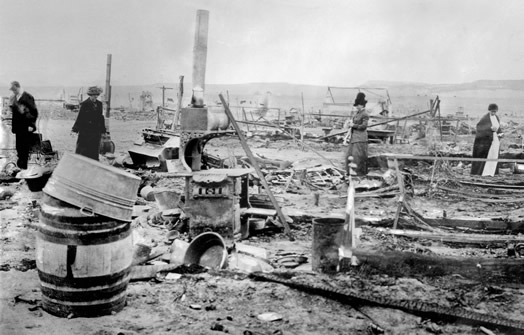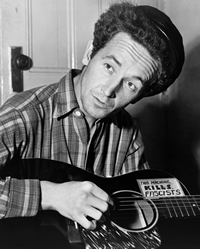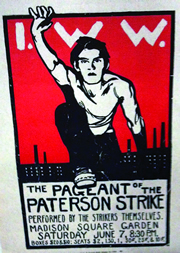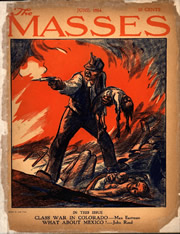Allegro
The Power of Art
This year, we commemorate the 100th anniversary of three major events in labor history. Thanks to the power of art, we will not forget…
Volume 113, No. 5May, 2013

The Ludlow Massacre was an attack by the Colorado National Guard and Colorado Fuel & Iron Company camp guards on a tent colony of 1,200 striking coal miners and their families at Ludlow, Colorado on April 20, 1914. Pictured above are the ruins of the Ludlow Colony in the direct aftermath of the massacre. Woody Guthrie’s song “Ludlow Massacre” tells the story of the tragedy.
Take a trip with me in 1913 to Calumet, Michigan and the copper country…” are the opening lines of one of the most haunting, powerful and depressing songs in the Woody Guthrie catalogue: “1913 Massacre.” I learned the song from a recording by Jack Elliot, who is still to this day the best interpreter of Woody Guthrie songs. The ballad is the telling of a real event in Michigan history when on Christmas Eve in 1913, miners and their families gathered in Italian Hall for a holiday party. As Guthrie’s ballad tells it, “copper boss thugs” yelled “fire!” from outside the hall and in the ensuing moments the crowd rushed for the door at the bottom of a set of stairs where the thugs outside held the door shut, causing some 73 people, mostly children, to smother to death.

When Woody Guthrie wrote songs about events in labor history, it was sometimes the only way to hear the workers’ point of view.
What is remarkable about this song and the story is that no one really knows exactly what happened on that tragic night outside of the fact that the deaths did occur and someone did yell “fire.” For decades, a version of the facts that contradicted Guthrie’s lyric had it that the doors at the bottom of the stairs opened inward, preventing the victims from fleeing from the building. This is what the local press reported. But the local press was controlled by the mine owners, according to Steve Lehto’s 2006 book, “Death’s Door: The Truth Behind Michigan’s Largest Mass Murder.” Lehto’s research (supported by photos) showed that the doors did, in fact, open outward, contrary to a myth so prevalent that a state historical marker declared it fact.
If it’s true that the establishment press denied the culpability of the “copper boss thugs,” what is undeniable is the power of Woody Guthrie’s song and how it brought the miner’s version of the story to the forefront of popular culture. Thousands of Americans (not to mention Woody Guthrie fans from around the globe) know no other history of this event than the one Guthrie tells. So the copper industry, with all their wealth, in the end lost the battle over the truth to a song that has been handed down to us through the singing of a few folk musicians. Steve Lehto’s book goes a long way to back up Woody Guthrie’s version of the event, though he is careful to point out the inaccuracies in the Guthrie song.

Greenwich Village artists, activists and intellectuals produced a pageant in 1913 in Madison Square Garden to tell the story of the weavers who were on strike against the silk mills in Paterson, New Jersey that year. Above, a poster advertising the pageant.
This year is also the centennial of an event that led to one of the most infamous union tragedies of the 20th century. Miners went out on strike in late 1913 in Colorado for recognition of their union and basic wage demands. Spurred by the murder of a union organizer by a guard working for the detective company known as Baldwin-Felts, the strike grew violent and the governor sent in troops to suppress the miners. The violence culminated in what is known as the Ludlow Massacre, when the state militia strafed the miners’ tent colony and set it on fire. “Eleven children and two women were smothered in the flames,” according to Philip Taft’s “The AFL in the Time of Gompers.” Again, many know the history of this tragedy from a Woody Guthrie song, “The Ludlow Massacre,” which numerous singers have recorded, bringing the tale to thousands.
The ballads that Woody Guthrie sings are ballads in the traditional sense of the word, where a story is told in verses and makes fables out of true events in history. Woody Guthrie was a master of this art form. Both ballads take their time leading to the tragic turns in each piece, slowly setting the scene and pulling the listener into the story and creating an emotional bond between the listener and the subjects of the ballad. By the end of each of these ballads, the listener can’t help but be saddened and enraged.
The intelligentsia of Greenwich Village in 1913 may have used some of the same approaches when they hosted a pageant to tell the story of the silk weavers who were on strike against the silk mills in Paterson, New Jersey that year. The great pageant was put on in Madison Square Garden. At this point in history, there was a convergence of movements that contributed to a strong solidarity effort between the strikers and artists and intellectuals in New York. The feminist and suffrage movement was in full swing and people like Margaret Sanger and Elizabeth Gurley Flynn got involved. In addition, the art movement, which was in the throes of change, more often than not was seen in concert with the political revolutionary movements of the time, including the plight of labor and the activity of the Industrial Workers of the World (IWW), who were brought in to lead the strike. The eight-hour day movement was gaining momentum and the Paterson strikers made a shorter work day one of their demands. The strike was inspiring for the use of songs and humor from each ethnic group of workers involved.

The cover art by John French Sloan from the June 1914 issue of The Masses, depicting the massacre.
The strike ended badly but the pageant was a huge success. John Reed, who wrote “Ten Days That Shook the World,” organized the pageant with the backing of Mabel Dodge, a well-known patron of the arts at the time. John Sloan, the founder of the Ashcan art movement, painted a 90-foot backdrop depicting the mills of Paterson, and strikers were brought in to help dramatize the story. The sold-out extravaganza ended with thousands of workers singing “The Internationale.”
Today, the Botto House in Haledon, New Jersey, where IWW leaders staged massive rallies for the strikers, is the home of the American Labor Museum (see www.LaborMuseum.net). A permanent exhibit of the strike features photos and artifacts from this important chapter of labor history. I recommend a visit. It’s just across the river. Standing in front of the photos in the exhibit inside this house where Big Bill Haywood and Elizabeth Gurley Flynn addressed the throngs from the balcony gives one a sense of the greatness of this chapter in labor history.
